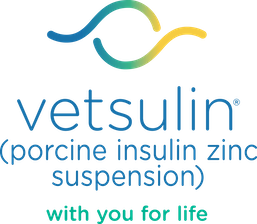

Starting Regulation with Vetsulin®
Learn More About Dosing & Administration
Presentation of a Dog with Diabetes
It is essential that animals presenting with severe ketoacidosis, anorexia, lethargy, dehydration and/or vomiting should be stabilized with short-acting insulin and appropriate supportive therapy until their condition is stabilized prior to starting Vetsulin therapy.
Initial Presentation:
- Perform a thorough physical examination and weigh the dog.
- Conduct laboratory testing including complete blood count, urinalysis (including sediment examination), and serum biochemistry profile.
- If indicated, rule out hypothyroidism, renal failure, inflammatory bowel disease, pancreatitis, exocrine pancreatic insufficiency, hyperadrenocorticism, growth hormone excess or acromegaly, neoplasia, and hepatic disease.
Diagnosing Canine Diabetes:
- Diabetes mellitus is not the only cause of polyuria/polydipsia and weight loss.
- Each dog should be examined thoroughly to rule out any other causes before starting insulin management.
- A preliminary diagnosis of diabetes mellitus based on clinical signs must be confirmed by blood and urine tests. Reference values for blood glucose range from 80–120 mg/dL (4.4–6.7 mmol/L) in dogs. The renal threshold is around 180 mg/dL (10 mmol/L). If the blood glucose concentration exceeds this threshold, glucose is excreted in the urine.
Once the Diagnosis of Diabetes Mellitus is Confirmed:
- Take time to explain thoroughly to the owner what diabetes is, that achieving regulation may take time (up to 1 to 3 months), and what the implications are for the family. Make sure the dog owner understands the therapy involved, and assure them that the dog should be able to live a happy, healthy life with consistent management. This is crucial, as complete cooperation of the owner is essential to the success of the management.
- Treat existing infections or other medical conditions. Many diseases will affect insulin metabolism.
- Introduce appropriate diet.
- Begin therapy with Vetsulin® (porcine insulin zinc suspension).
Starting Vetsulin in Clinic
Evaluate Dosage Needed
- Weigh the dog. In the event of a fraction of a kilogram, round the body weight down rather than up. For example, a 12.9-kg dog should be dosed as a 12-kg dog. If the dog is grossly overweight, utilize the optimal body weight for calculating the starting dosage of Vetsulin.
- Establish a starting dose based on the labeled dosage of 0.5 IU insulin/kg of body weight. This initial dose should be given once daily concurrently with or right after a meal.
Establish a Starting Dose
- Begin with once-daily injections, then evaluate.
- Some dog owners may do best by easing into the routine of diabetes management with once-daily injections. This is preferable to having an overwhelmed client who sees euthanasia as the only viable option. After acclimating to the ease of giving injections, the client is more likely to willingly accept twice-daily injections, if needed.
- Remember that hyperglycemia does not kill dogs; hypoglycemia can.
- The majority of dogs (two-thirds) will require twice-daily Vetsulin injections.
- Keep the dog hospitalized for the day to verify that the starting dose does not cause hypoglycemia.
Topics for Pet Parent Education
- The majority of dogs (two-thirds) will require twice-daily Vetsulin injections
- How to administer injections
- How to identify and treat hypoglycemia
- Parameters to monitor at home
- Preferred diet and frequency of meals
- Exercise recommendations
Discharge dog to pet parent’s care for one week
This first period allows the dog and owner to acclimate to the injections.
At home, have the owner:
- Monitor and record water and food consumption.
- Monitor and record urine glucose and/or ketone bodies.
- Maintain starting dose and frequency of administration for the entire week.
- Watch for signs of hypoglycemia. If so, they should contact their veterinarian immediately.
Help Your Practice Manage Diabetes Mellitus
View and download resources and tools that will assist your hospital, inform your team, and help with clients.

Blood Glucose Curve Generator
Create a blood glucose curve to monitor and evaluate diabetes treatments.

Client Discharge Form
Create a customized, printable form for clients about their new diagnosis.

Diabetes Resources
Access online tools and more to support staff and pet parents.
No items to show.
Learn More About Dosing & Administration
Important Safety Information:
Vetsulin® should not be used in dogs known to have a systemic allergy to pork or pork products. Vetsulin is contraindicated during periods of hypoglycemia. Keep out of reach of children. As with all insulin products, careful patient monitoring for hypoglycemia and hyperglycemia is essential to attain and maintain adequate glycemic control and prevent associated complications. Overdosage can result in profound hypoglycemia and death. The safety and effectiveness of Vetsulin in puppies, breeding, pregnant, and lactating dogs has not been evaluated. See package insert for full information regarding contraindications, warnings, and precautions.
References:
1. Martin GJ, Rand JS. Pharmacology of a 40 IU/ml porcine lente insulin preparation in diabetic cats: findings during the first week and after 5 or 9 weeks of therapy. J Feline Med Surg. 2001;3(1):23–30. 2. Vetsulin® (porcine insulin zinc suspension) [Freedom of Information Summary]. Millsboro, DE: Intervet Inc.; 2008. 3. Data on file, Merck Animal Health. 4. Graham PA, Nash AS, McKellar QA. Pharmacokinetics of porcine insulin zinc suspension in diabetic dogs. J Small Anim Pract. 1997;38(10):434–438. 5. Martin GJ, Rand JS. Pharmacokinetic and Pharmacodynamic Study of Caninsulin in Cats with Diabetes Mellitus. 2000: Internal Study Report. 6. Feldman EC, Nelson RW. Canine and Feline Endocrinology and Reproduction. 3rd ed. St. Louis, MO: Saunders; 2004:539–579. 7. Tennant B, ed. BSAVA Small Animal Formulary. 4th ed. Gloucestershire, UK: British Small Animal Veterinary Association; 2002. 8. Feldman EC, Nelson RW. Canine and Feline Endocrinology and Reproduction. 3rd ed. St. Louis, MO: Saunders; 2004:486–538. 9. Reusch C. Feline diabetes mellitus. In: Ettinger SJ, Feldman EC, eds. Textbook of Veterinary Internal Medicine. 7th ed. St. Louis, MO: Saunders; 2010:1796–1816. 10. Nelson RW. Canine diabetes mellitus. In: Ettinger SJ, Feldman EC, eds. Textbook of Veterinary Internal Medicine. 7th ed. St. Louis, MO: Saunders; 2010:1782–1796. 11. Burgaud S, Riant S, Piau N. Comparative laboratory evaluation of dose delivery using a veterinary insulin pen. In: Proceedings of the WSAVA/FECAVA/BSAVA congress; 12–15 April 2012; Birmingham, UK. Abstract 121. 12. Burgaud S, Guillot R, Harnois-Milon G. Clinical evaluation of a veterinary insulin pen in diabetic dogs. In: Proceedings of the WSAVA/ FECAVA/BSAVA congress; 12–15 April 2012; Birmingham, UK. Abstract 122. 13. Burgaud S, Guillot R, Harnois-Milon G. Clinical evaluation of a veterinary insulin pen in diabetic cats. In: Proceedings of the WSAVA/FECAVA/BSAVA congress; 12–15 April 2012; Birmingham, UK. Abstract 45. 14. Davison LJ, Walding B, Herrtage ME, Catchpole B. Anti-insulin antibodies in diabetic dogs before and after treatment with different insulin preparations. J Vet Intern Med. 2008;22:1317-1325. 15. Banfield State of Pet Health 2016 Report. p 12-13.
